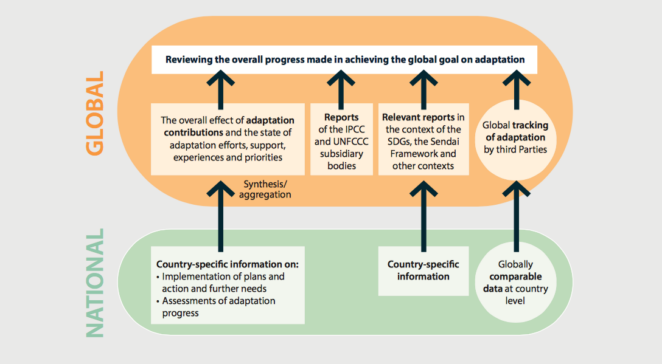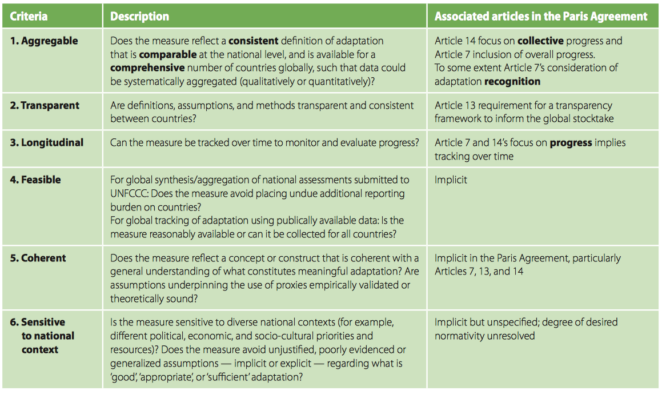UN Adaptation Gap Report 2017

Introduction
The Paris Agreement, adopted in 2015, established the global goal on adaptation of enhancing adaptive capacity, strengthening resilience and reducing vulnerability to climate change, with a view to contributing to sustainable development and ensuring an adequate adaptation response in the context of the temperature goal. The 2017 Adaptation Gap Report, which is the third global Adaptation Gap Report by UN Environment – prepared in collaboration with the Global Centre of Excellence on Climate Adaptation – focuses on one of the key questions arising in the wake of the global goal: What are the ways forward to assess progress towards the global goal on adaptation?
This report* explores key opportunities and challenges associated with assessing progress on adaptation at the global level. The report synthesizes information relevant for the ongoing work under the United Nations Framework Convention on Climate Change (UNFCCC) to prepare for the implementation of the Paris Agreement. In contrast to previous Adaptation Gap Reports, the 2017 report focuses on issues relating to frameworks, comprising concepts, methodologies and data, rather than on assessing a particular dimension of the adaptation gap. Future Adaptation Gap Reports will return to assessments of specific adaptation gaps.
*Download the full report from the right hand column, or find the executive summary in the links below.
Key findings
The report’s main findings are summarised as follows:
1. Globally comparable metrics that track progress towards the global goal on adaptation based on country-level information, while avoiding undue burden on countries, provide additional opportunities yet pose a considerable challenge.
- Figure ES.2 outlines how various sources of information may feed into an assessment of the overall progress made in achieving the global goal on adaptation.

Figure ES.2: Reviewing the overall progress in achieving the global goal on adaptation based on multiple sources of information (page xiv of the Executive Summary).
2. Existing tools and frameworks for adaptation assessment, including for monitoring and evaluation (M&E), are generally geared towards project- to -country-level assessments and are typically not designed to be aggregated at global level.
- To assess progress towards the global goal on adaptation, it is necessary to ensure not only comparability of information across countries, but also to utilize metrics that can be collected repeatedly.
- There is also a clear correlation between the depth of information an adaptation assessment can provide and the resources available.
3. National adaptation M&E systems can facilitate global knowledge sharing and transparency in addition to offering domestic benefits, such as better informed planning and decision-making.
- Country experiences indicate that the development of a national adaptation M&E system should start by clarifying the purpose(s) of the system.
- Clarification of purpose is essential to inform the design of appropriate methodologies and metrics and to assess information and data needs.
- The same applies for assessing adaptation progress globally.
4. Current national M&E systems mainly focus on monitoring adaptation. Few countries have undertaken an evaluation of national adaptation progress.
5. There are currently no agreed-upon methods, indicators, metrics or frameworks designed for an assessment of progress towards the global goal on adaptation, yet existing frameworks can provide insights into opportunities for aggregating and synthesizing country-level progress.
- A review of existing frameworks for adaptation indicates the following key desirable criteria for an adaptation assessment framework at global level (table ES.1):
- capacity to aggregate or synthesize country-level data,
- transparency,
- consideration of progress over time,
- avoiding undue burden on countries,
- inclusion of proxy indicators that are coherent with a collective understanding of meaningful adaptation,
- and sensitivity to national vulnerabilities, resources, and contexts.
Lessons Learnt
In summary, the 2017 Adaptation Gap Report points to the following key insights for informing an assessment of global progress on adaptation:
1. Frameworks that are based on nationally determined proximity-to-target approaches have the greatest potential to respect a diversity of national contexts while facilitating global assessment of progress. There are no one-size-fits-all metrics given the diversity of resources, vulnerabilities, and adaptive capacity.
2. A transparent assessment of global progress is facilitated if national reporting of descriptive metrics (including activities and results) is clearly distinguished from evaluative metrics. Evaluative metrics reported by nations are poorly suited to quantification of progress at the global level.
- While countries may choose to include evaluative metrics in national reporting, such metrics are best suited to qualitative synthesis when assessing global progress.
- Despite this, some evaluative metrics should probably be standardized to facilitate widespread adoption, including special consideration of the most vulnerable countries and vulnerable groups within countries, and principles such as equality and equity between genders and across other dimensions of vulnerability.
3. Global review of adequacy and effectiveness, which typically involves the use of evaluative metrics, is unlikely to be achievable through standardized or quantifiable indicators alone.
- Countries may assess how well they are achieving their targets based on their climate risk profile and other considerations.
- To increase transparency for global synthesis of progress, these assessments are well suited to qualitative reporting formats and peer or expert review rather than standardized indicator scoring.
- A review of frameworks from outside of the adaptation field highlights the role of peer review mechanisms in increasing reliability, validity, and consistency of adaptation reporting.
4. A focus on the contribution made to a result rather than strict attribution is emerging as a more useful concept to link national efforts with results.
- Attributing outcomes and impact to inputs and action directly is unlikely to be reliable or comparable at the national level or consistent across countries.
- Instead, narratives can be used to assess contribution and qualitative evidence to support quantitative indicators.
5. Longitudinal assessment of adaptation progress over time is reflected relatively poorly in existing assessment frameworks, but will be critical in a global effort to review adaptation progress over time. This implies the use of indicators of change or progress in addition to static measures of effort.
6. The SDGs and the Sendai Framework offer considerable opportunities for alignment via shared indicators, joint implementation, capacity building, and creation of policy support.
7. Third party information can complement information provided by countries. The IPCC, other international bodies, and the broader research community can be called upon to provide information, and to help further develop methodologies suitable for global assessment of adaptation progress.
Suggested citation
UNEP 2017. The Adaptation Gap Report 2017. United Nations Environment Programme (UNEP), Nairobi, Kenya
Further reading
- The Adaptation Finance Gap Report 2016
- Read previous Adaptation Gap reports at http://drustage.unep.org/adaptationgapreport/
- Assessing Adaptation Through a Gender Lens
- PROVIA Guidance on Assessing Vulnerability, Impacts and Adaptation to Climate Change
- Using wellbeing indicators and climate information to assess adaptation effectiveness

(0) Comments
There is no content